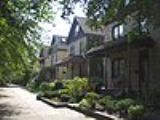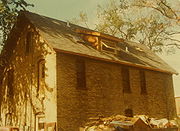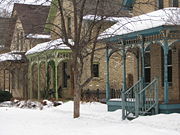
Milwaukee Avenue Historic District
Encyclopedia
The Milwaukee Avenue Historic District is a historic district
in Minneapolis, Minnesota
in the Seward neighborhood
. The district comprises two city blocks of small homes on quarter-sized lots. These houses were built between 1884 and 1890 by William Ragan, a Minneapolis real estate speculator. Built for lower-income residents, the houses had deteriorated in condition by the end of World War II
, and by the 1970s, were planned for demolition. A group of residents and concerned citizens fought to save the houses, eventually leading to their inclusion on the National Register of Historic Places
and the federal protection and rehabilitation that comes with the designation. Today, the houses sit along a bike- and pedestrian-friendly mall on which motor traffic is prohibited.
 During the late 19th century, the population of Minneapolis was growing rapidly, increasing 351 percent from 1880 to 1890. With the number of people moving into the city, lower-cost housing was needed for immigrants who were new to Minnesota. The street had originally been plat
During the late 19th century, the population of Minneapolis was growing rapidly, increasing 351 percent from 1880 to 1890. With the number of people moving into the city, lower-cost housing was needed for immigrants who were new to Minnesota. The street had originally been plat
ted as an alley between 22nd and 23rd Avenues South, but William Ragan developed it as a street and labeled it 22½ Avenue. The houses were situated close together on narrow lots, with very narrow side yards and no front yards. This almost gives the impression of rowhouses. Most of the houses were built with brick veneer on timber frames, and they have uniform-sized roof slopes, modified flat arch windows, and open front porches.
The street kept its '½' until 1906, when petitioners asked the Minneapolis City Council
to change the street's name to Woodland Avenue because they said the '½' made them feel like they lived in an alley. For an unknown reason, the street's name was not changed to Woodland Avenue, but to Milwaukee Avenue. The Avenue's proximity to the Milwaukee Short Line Railroad has been suggested as a cause.
 By the time World War II
By the time World War II
was over, the houses on Milwaukee Avenue were falling into disrepair. They had been neglected throughout the Great Depression
and wartime. In 1959, the City of Minneapolis presented a plan for the Seward neighborhood, which listed the houses on Milwaukee Avenue in 'deteriorated' condition, meaning they had no indoor plumbing or were severely battered.
In many other neighborhoods, the City had renewed and thus gentrified areas without public hearings, because residents of those neighborhoods were low-income renters. In Milwaukee Avenue's case, however, the residents were of medium income, and seasoned protesters, since many had protested the Vietnam War
. By 1970, the City of Minneapolis planned to raze the Milwaukee Avenue houses using funds from the Housing and Urban Development
(HUD) program.
The residents of Milwaukee Avenue and the surrounding Seward neighborhood formed the Seward West Project Area Committee (PAC) in order to try to save the Milwaukee Avenue homes. They argued that the houses had significant historic value and needed to be preserved. The City argued that the houses were legally nonconforming, and rehabilitating them would cost more than just building new houses.
The City furthered its plan of renewing the area and took no heed of the PAC. In response, the PAC secretly submitted an application to the National Register of Historic Places
for the Milwaukee Avenue district. It was approved on May 2, 1974 by Secretary of the Interior Rogers CB Morton
. This meant that the City could not alter or destroy the houses using federal funds without a public hearing.
Nine of Milwaukee Avenue's houses had to be destroyed due to their decrepit conditions and a tenth was moved elsewhere. In the spaces where these houses once stood, townhomes were built, mirroring the style of the original houses. The rest of the houses got indoor plumbing, new basements, improved woodwork and porches added on. Additionally, a pedestrian mall was built down the center of Milwaukee Avenue to replace a one way street. The Avenue is now bike and pedestrian friendly, and cars are prohibited.
 Milwaukee Avenue still stands today. In 2007, to celebrate the 30th anniversary of Milwaukee Avenue's rehabilitation, self-guided walking tours of eight of the houses were offered to the public.
Milwaukee Avenue still stands today. In 2007, to celebrate the 30th anniversary of Milwaukee Avenue's rehabilitation, self-guided walking tours of eight of the houses were offered to the public.
The houses were featured on local CBS
station WCCO-TV
's Finding Minnesota series in 2005. The two-minute video segment about the avenue featured interviews with a resident of Milwaukee Avenue, as well as Bob Roscoe, an activist who led the fight to save Milwaukee Avenue.
Historic district
A historic district or heritage district is a section of a city which contains older buildings considered valuable for historical or architectural reasons. In some countries, historic districts receive legal protection from development....
in Minneapolis, Minnesota
Minneapolis, Minnesota
Minneapolis , nicknamed "City of Lakes" and the "Mill City," is the county seat of Hennepin County, the largest city in the U.S. state of Minnesota, and the 48th largest in the United States...
in the Seward neighborhood
Seward, Minneapolis
The Seward neighborhood in Minneapolis, Minnesota, U.S., is geographically southeast of downtown and defined by the triangle of land bordered by Hiawatha Avenue to the west, Minneapolis Midtown Greenway to the south, the Mississippi River to the east, and Interstate 94 to the north...
. The district comprises two city blocks of small homes on quarter-sized lots. These houses were built between 1884 and 1890 by William Ragan, a Minneapolis real estate speculator. Built for lower-income residents, the houses had deteriorated in condition by the end of World War II
World War II
World War II, or the Second World War , was a global conflict lasting from 1939 to 1945, involving most of the world's nations—including all of the great powers—eventually forming two opposing military alliances: the Allies and the Axis...
, and by the 1970s, were planned for demolition. A group of residents and concerned citizens fought to save the houses, eventually leading to their inclusion on the National Register of Historic Places
National Register of Historic Places
The National Register of Historic Places is the United States government's official list of districts, sites, buildings, structures, and objects deemed worthy of preservation...
and the federal protection and rehabilitation that comes with the designation. Today, the houses sit along a bike- and pedestrian-friendly mall on which motor traffic is prohibited.
Early history

Plat
A plat in the U.S. is a map, drawn to scale, showing the divisions of a piece of land. Other English-speaking countries generally call such documents a cadastral map or plan....
ted as an alley between 22nd and 23rd Avenues South, but William Ragan developed it as a street and labeled it 22½ Avenue. The houses were situated close together on narrow lots, with very narrow side yards and no front yards. This almost gives the impression of rowhouses. Most of the houses were built with brick veneer on timber frames, and they have uniform-sized roof slopes, modified flat arch windows, and open front porches.
The street kept its '½' until 1906, when petitioners asked the Minneapolis City Council
Minneapolis City Council
The Minneapolis City Council is the governing body of the City of Minneapolis. The City Council is composed of 13 single member districts, called wards. Barbara Johnson is president of the council. The council is dominated by members of the DFL Party with 12 members. The Green Party has one member...
to change the street's name to Woodland Avenue because they said the '½' made them feel like they lived in an alley. For an unknown reason, the street's name was not changed to Woodland Avenue, but to Milwaukee Avenue. The Avenue's proximity to the Milwaukee Short Line Railroad has been suggested as a cause.
Deterioration and restoration

World War II
World War II, or the Second World War , was a global conflict lasting from 1939 to 1945, involving most of the world's nations—including all of the great powers—eventually forming two opposing military alliances: the Allies and the Axis...
was over, the houses on Milwaukee Avenue were falling into disrepair. They had been neglected throughout the Great Depression
Great Depression
The Great Depression was a severe worldwide economic depression in the decade preceding World War II. The timing of the Great Depression varied across nations, but in most countries it started in about 1929 and lasted until the late 1930s or early 1940s...
and wartime. In 1959, the City of Minneapolis presented a plan for the Seward neighborhood, which listed the houses on Milwaukee Avenue in 'deteriorated' condition, meaning they had no indoor plumbing or were severely battered.
In many other neighborhoods, the City had renewed and thus gentrified areas without public hearings, because residents of those neighborhoods were low-income renters. In Milwaukee Avenue's case, however, the residents were of medium income, and seasoned protesters, since many had protested the Vietnam War
Vietnam War
The Vietnam War was a Cold War-era military conflict that occurred in Vietnam, Laos, and Cambodia from 1 November 1955 to the fall of Saigon on 30 April 1975. This war followed the First Indochina War and was fought between North Vietnam, supported by its communist allies, and the government of...
. By 1970, the City of Minneapolis planned to raze the Milwaukee Avenue houses using funds from the Housing and Urban Development
United States Department of Housing and Urban Development
The United States Department of Housing and Urban Development, also known as HUD, is a Cabinet department in the Executive branch of the United States federal government...
(HUD) program.
The residents of Milwaukee Avenue and the surrounding Seward neighborhood formed the Seward West Project Area Committee (PAC) in order to try to save the Milwaukee Avenue homes. They argued that the houses had significant historic value and needed to be preserved. The City argued that the houses were legally nonconforming, and rehabilitating them would cost more than just building new houses.
The City furthered its plan of renewing the area and took no heed of the PAC. In response, the PAC secretly submitted an application to the National Register of Historic Places
National Register of Historic Places
The National Register of Historic Places is the United States government's official list of districts, sites, buildings, structures, and objects deemed worthy of preservation...
for the Milwaukee Avenue district. It was approved on May 2, 1974 by Secretary of the Interior Rogers CB Morton
Rogers Morton
Rogers Clark Ballard Morton was an American politician who served as Secretary of the Interior and Secretary of Commerce under Presidents Richard Nixon and Gerald Ford, respectively...
. This meant that the City could not alter or destroy the houses using federal funds without a public hearing.
Nine of Milwaukee Avenue's houses had to be destroyed due to their decrepit conditions and a tenth was moved elsewhere. In the spaces where these houses once stood, townhomes were built, mirroring the style of the original houses. The rest of the houses got indoor plumbing, new basements, improved woodwork and porches added on. Additionally, a pedestrian mall was built down the center of Milwaukee Avenue to replace a one way street. The Avenue is now bike and pedestrian friendly, and cars are prohibited.
Milwaukee Avenue today

The houses were featured on local CBS
CBS
CBS Broadcasting Inc. is a major US commercial broadcasting television network, which started as a radio network. The name is derived from the initials of the network's former name, Columbia Broadcasting System. The network is sometimes referred to as the "Eye Network" in reference to the shape of...
station WCCO-TV
WCCO-TV
WCCO-TV, is the CBS owned and operated television station that serves the Minneapolis-St. Paul area of Minnesota. Its transmitter is at the Telefarm complex in Shoreview, Minnesota.- History :...
's Finding Minnesota series in 2005. The two-minute video segment about the avenue featured interviews with a resident of Milwaukee Avenue, as well as Bob Roscoe, an activist who led the fight to save Milwaukee Avenue.

